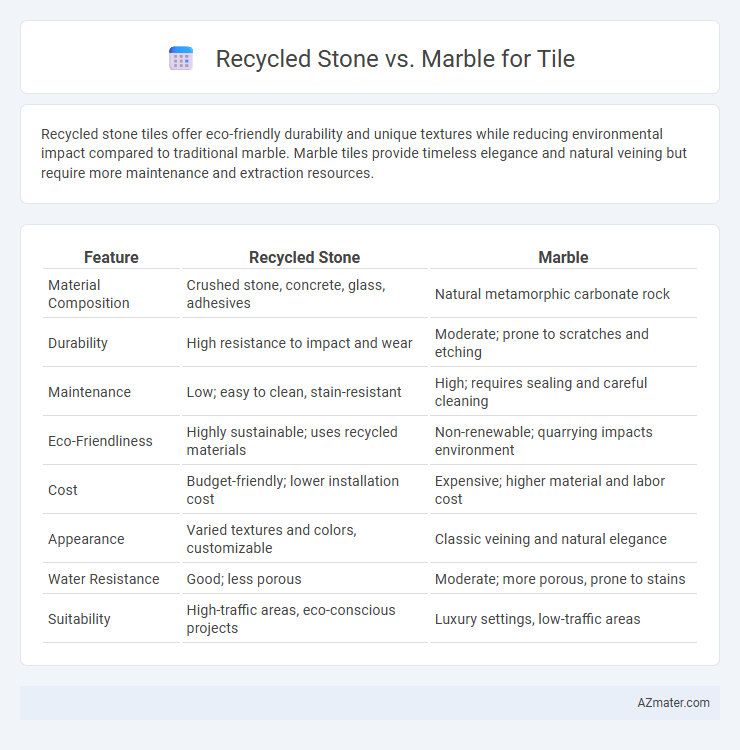Recycled stone tiles offer eco-friendly durability and unique textures while reducing environmental impact compared to traditional marble. Marble tiles provide timeless elegance and natural veining but require more maintenance and extraction resources.
Table of Comparison
| Feature | Recycled Stone | Marble |
|---|---|---|
| Material Composition | Crushed stone, concrete, glass, adhesives | Natural metamorphic carbonate rock |
| Durability | High resistance to impact and wear | Moderate; prone to scratches and etching |
| Maintenance | Low; easy to clean, stain-resistant | High; requires sealing and careful cleaning |
| Eco-Friendliness | Highly sustainable; uses recycled materials | Non-renewable; quarrying impacts environment |
| Cost | Budget-friendly; lower installation cost | Expensive; higher material and labor cost |
| Appearance | Varied textures and colors, customizable | Classic veining and natural elegance |
| Water Resistance | Good; less porous | Moderate; more porous, prone to stains |
| Suitability | High-traffic areas, eco-conscious projects | Luxury settings, low-traffic areas |
Introduction to Recycled Stone and Marble Tiles
Recycled stone tiles are manufactured from repurposed natural stone fragments and industrial byproducts, offering an eco-friendly alternative to traditional materials. Marble tiles, formed from metamorphic limestone, are prized for their classic beauty, unique veining, and durability in flooring and wall applications. Both options provide distinct aesthetic and environmental benefits, with recycled stone emphasizing sustainability and marble emphasizing timeless elegance.
Composition and Production Processes
Recycled stone tiles are composed primarily of crushed stone fragments, often bound with resins or cementitious materials, utilizing waste materials from construction or industrial byproducts. Marble tiles are natural stone products quarried from metamorphic limestone, processed through cutting, polishing, and finishing to reveal their characteristic veining and color. Production of recycled stone tiles typically involves crushing, mixing with binders, molding, and curing, offering an eco-friendly alternative, while marble requires extensive quarrying, cutting, and surface treatment, which is more resource-intensive.
Environmental Impact Comparison
Recycled stone tiles significantly reduce environmental impact by diverting waste from landfills and lowering the demand for quarrying compared to traditional marble, which requires extensive mining and results in habitat disruption and high carbon emissions. The production of recycled stone uses less energy and generates fewer greenhouse gases, contributing to a smaller carbon footprint. Marble extraction and processing involve heavy water use and chemical treatments, whereas recycled stone promotes sustainable resource use through material reclamation and reduced natural resource depletion.
Aesthetic Differences and Design Options
Recycled stone tiles offer a unique, eco-friendly aesthetic with varied textures and mixed coloration, creating a modern, rustic, or industrial look ideal for contemporary designs. Marble tiles provide timeless elegance characterized by natural veining patterns and a polished surface, suitable for classic, luxurious interiors. Design options with recycled stone include custom blends and irregular shapes, while marble offers a range of finishes from honed to high gloss, enhancing its versatility in upscale projects.
Durability and Longevity Analysis
Recycled stone tiles demonstrate impressive durability due to their composite nature, often combining crushed stone with strong binding agents that resist cracking and chipping under heavy foot traffic. Marble tiles, while aesthetically superior, are more susceptible to scratches, stains, and etching from acidic substances, requiring regular sealing and maintenance to preserve longevity. In high-traffic or commercial settings, recycled stone typically offers greater longevity and cost-effectiveness compared to the more delicate and maintenance-intensive marble options.
Cost Effectiveness and Pricing
Recycled stone tiles generally offer a more cost-effective solution compared to natural marble, as they utilize repurposed materials that lower production expenses and reduce environmental impact. Marble tiles, while prized for their unique veining and luxurious appeal, typically come with higher upfront costs due to quarrying, processing, and transportation. Choosing recycled stone can significantly reduce installation and maintenance expenses, making it an economical option for budget-conscious projects seeking aesthetic versatility.
Maintenance and Cleaning Requirements
Recycled stone tiles require less frequent sealing compared to marble, making maintenance more straightforward and cost-effective. Marble tiles demand regular sealing and careful cleaning with pH-neutral products to prevent etching and staining from acidic substances. Both materials benefit from prompt spill cleanup, but recycled stone's higher resistance to scratches and stains reduces overall maintenance efforts.
Installation Considerations
Recycled stone tiles offer lighter weight and easier handling during installation compared to traditional marble, reducing labor time and effort. Marble requires precise cutting and sealing to prevent damage and staining, demanding skilled professionals and specialized tools. Both materials benefit from a substrate with proper moisture barriers, but recycled stone's uniform thickness can simplify alignment and grout application.
Suitability for Different Spaces
Recycled stone tiles offer exceptional durability and sustainability, making them ideal for high-traffic areas such as kitchens and commercial spaces, while marble tiles provide a luxurious aesthetic suited for bathrooms, living rooms, and low-traffic zones. The porous nature of marble requires regular sealing to prevent stains, limiting its use in wet or heavily used environments, whereas recycled stone's resistance to moisture and wear enhances its versatility. Selecting the appropriate tile material depends on balancing aesthetic preferences with practical requirements like maintenance, durability, and environmental impact.
Final Verdict: Choosing Between Recycled Stone and Marble
Recycled stone offers an eco-friendly alternative with unique textures and lower environmental impact, making it suitable for sustainable tile projects. Marble provides timeless elegance, exceptional durability, and natural veining that enhances luxury interiors. When choosing between recycled stone and marble for tiles, prioritize sustainability and budget for recycled options, or opt for marble for classic aesthetics and high-end finishes.

Infographic: Recycled stone vs Marble for Tile
 azmater.com
azmater.com